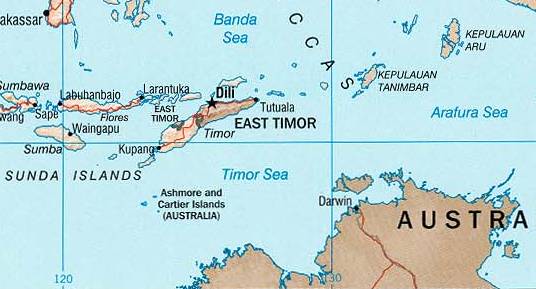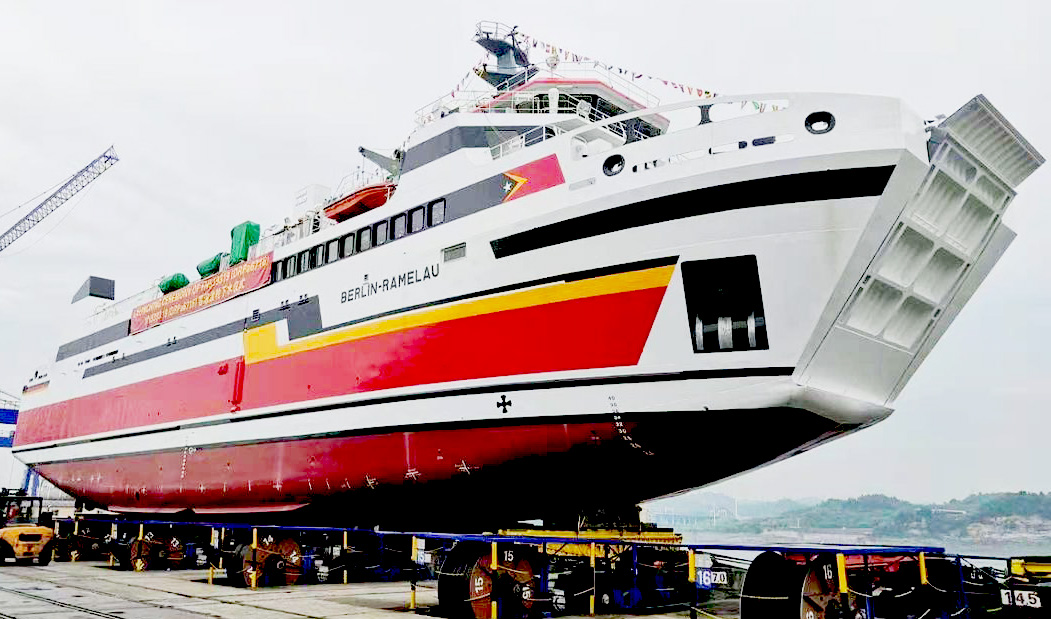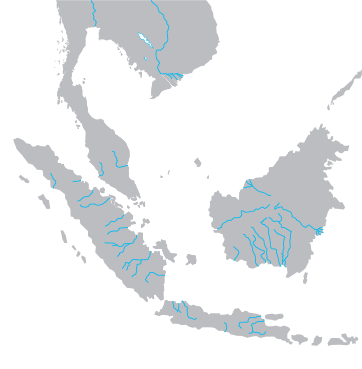|
Timor Sea
The Timor Sea (, , or ) is a relatively shallow sea in the Indian Ocean bounded to the north by the island of Timor with Timor-Leste to the north, Indonesia to the northwest, Arafura Sea to the east, and to the south by Australia. The Sunda Trench marks the deepest point of the Timor Sea with a depth of more than 3300 metres, separating the continents of Oceania in the southeast and Asia to the northwest and north. The Timor sea is prone to earthquakes and tsunamis north of the Sunda Trench, due to its location on the Ring of Fire as well as volcanic activity and can experience major cyclones, due to the proximity from the Equator. The sea contains a number of reefs, uninhabited islands and significant hydrocarbon reserves. International disputes emerged after the reserves were discovered resulting in the signing of the Timor Sea Treaty. The Timor Sea was hit by the worst Montara oil spill, oil spill for 25 years in 2009. It is possible that Australia's first inhabitants cros ... [...More Info...] [...Related Items...] OR: [Wikipedia] [Google] [Baidu] |
Arafura Sea
The Arafura Sea (or Arafuru Sea) lies west of the Pacific Ocean, overlying the continental shelf between Australia and Western New Guinea (also called Papua), which is the Indonesian part of the Island of New Guinea. Geography The Arafura Sea is bordered by the Gulf of Carpentaria and the continent of Australia to the south, the Timor Sea to the west, the Banda and Seram seas to the northwest, and the Torres Strait to the east. (Just across the strait, farther to the east, lies the Coral Sea). The Arafura Sea is long and wide. The depth of the sea is in most places, with the depth increasing to the west. The sea lies over the Arafura Shelf, which is a section of the Sahul Shelf. When sea levels were low during the last glacial maximum, the Arafura Shelf, the Gulf of Carpentaria and the Torres Strait formed a large, flat, land bridge that connected Australia and New Guinea and eased the migration of humans from Asia into Australia. The combined landmass formed the continent of ... [...More Info...] [...Related Items...] OR: [Wikipedia] [Google] [Baidu] |
Vessoru, East Timor
The administrative posts (formerly subdistricts) of Timor-Leste are subdivided into 442 ''sucos'' ("villages") and 2,336 ''aldeias'' ("communities"). ''Sucos'' have been part of the country's administrative system since the 20th century, under Portuguese, Japanese, Indonesian, and independent rule. List Aileu Municipality * Aileu Administrative Post ** Aissirimou ** Bandudato ** Fahiria ** Fatubossa ** Hoholau ** Lahae ** Lauisi ** Saboria ** Seloi Craic ** Seloi Malere ** Liurai ** Lequitura * Laulara Administrative Post ** Cotolau ** Fatisi ** Madabeno ** Talitu ** Tohumeta ** Bocalelo * Lequidoe Administrative Post ** Acubilitoho ** Bereleu ** Betulau ** Fahisoi ** Faturilau ** Manucassa ** Namolesso * Remexio Administrative Post ** Acumau ** Fadabloco ** Fahisoi ** Faturasa ** Hautoho ** Maumeta ** Liurai ** Tulataqueo Ainaro Municipality * Ainaro Administrative Post ** Ainaro ** Cassa ** Manutaci ** Mau-Nuno ** Mau-Ulo ** ... [...More Info...] [...Related Items...] OR: [Wikipedia] [Google] [Baidu] |
Equator
The equator is the circle of latitude that divides Earth into the Northern Hemisphere, Northern and Southern Hemisphere, Southern Hemispheres of Earth, hemispheres. It is an imaginary line located at 0 degrees latitude, about in circumference, halfway between the North Pole, North and South Pole, South poles. The term can also be used for any other celestial body that is roughly spherical. In three-dimensional space, spatial (3D) geometry, as applied in astronomy, the equator of a rotating spheroid (such as a planet) is the parallel (circle of latitude) at which latitude is defined to be 0°. It is an imaginary line on the spheroid, equidistant from its geographical pole, poles, dividing it into northern and southern hemispheres. In other words, it is the intersection of the spheroid with the plane (geometry), plane perpendicular to its axis of rotation and midway between its geographical poles. On and near the equator (on Earth), noontime sunlight appears almost directly o ... [...More Info...] [...Related Items...] OR: [Wikipedia] [Google] [Baidu] |
Van Diemen Gulf
Van Diemen Gulf is a gulf in the Northern Territory of Australia. It connects to the Timor Sea in the north via Dundas Strait. Most of its area is also gazetted as a locality with the name Van Diemen Gulf. History The gulf was named after the Dutch colonial governor, Anthony van Diemen (1593–1645). Phillip Parker King and his crew in the 76-tonne cutter surveyed the coastline in early 1818, encountering local Aboriginal people and proas sailed by Makassans, and passed by the Gulf on other voyages. Geography The gulf connects to the Timor Sea in the north via Dundas Strait, and is also connected to the Beagle Gulf in the west by the Clarence Strait. It is partially enclosed by Melville Island and the Cobourg Peninsula, and measures about by . Rivers draining into the Gulf include the South Alligator River, the East Alligator River, the Mary River, Wildman River and the Adelaide River. The Kakadu National Park adjoins its south-east coast. Administrative statu ... [...More Info...] [...Related Items...] OR: [Wikipedia] [Google] [Baidu] |
Beagle Gulf
Beagle Gulf is a Bay, gulf in the Northern Territory of Australia which opens on its west side to the Timor Sea. The gulf is bounded to the south by the mainland and to the north by Bathurst Island (Northern Territory), Bathurst and Melville Island (Australia), Melville Islands. It is connected to Van Diemen Gulf in the east by Clarence Strait (Northern Territory), Clarence Strait. Its south coast includes the natural harbours of Darwin Harbour, Darwin and Bynoe Harbour, Bynoe. It is approximately 100 km long and 50 km wide. It surrounds the Quail Island (Northern Territory), Quail Island Group. Name Beagle Gulf was named after the ship HMS Beagle, HMS ''Beagle'', on which Charles Darwin and Robert Fitzroy sailed around parts of Australia. The ''Cambridge Dictionary of Australian Places'' incorrectly states that "it was named in 1836 by Robert Fitzroy, commander of HMS Beagle, after his ship. The Beagle charted the area with Charles Darwin aboard as naturalist." H ... [...More Info...] [...Related Items...] OR: [Wikipedia] [Google] [Baidu] |
Joseph Bonaparte Gulf
Joseph Bonaparte Gulf is a large body of water off the coast of the Northern Territory and Western Australia and part of the Timor Sea. It was named after Joseph Bonaparte, brother of Napoleon and King of Naples (1806–1808) and then Spain (1808–1813) by French explorer and naturalist Nicolas Baudin in 1803. It is also often referred to in Australia as the "Bonaparte Gulf". Description The Keep River and Victoria River drain into the gulf in the Northern Territory, the former close to the Western Australia – Northern Territory border. The Ord River, Pentecost River, Durack River, King River and the Forrest River drain into the Cambridge Gulf, another gulf within the southern part of the Joseph Bonaparte Gulf. The Legune (Joseph Bonaparte Bay) Important Bird Area lies at the south-eastern end of the gulf. The Bonaparte Basin is a large sedimentary basin underlying the gulf and a large part of the Timor Sea The Timor Sea (, , or ) is a relatively shallow sea ... [...More Info...] [...Related Items...] OR: [Wikipedia] [Google] [Baidu] |
Timor See
Timor (, , ) is an island at the southern end of Maritime Southeast Asia, in the north of the Timor Sea. The island is divided between the sovereign states of Timor-Leste in the eastern part and Indonesia in the western part. The Indonesian part, known as West Timor, constitutes part of the province of East Nusa Tenggara. Within West Timor lies an exclave of Timor-Leste called Oecusse District. The island covers an area of . The name is a variant of ''timur'', Malay for "east"; it is so called because it lies at the eastern end of the Lesser Sunda Islands. Mainland Australia is less than 500 km away, separated by the Timor Sea. Language, ethnic groups and religion Anthropologists identify eleven distinct ethno-linguistic groups in Timor. The largest are the Atoni of western Timor and the Tetum of central and eastern Timor. Most indigenous Timorese languages belong to the Timor–Babar branch of the Austronesian languages spoken throughout the Indonesian archipe ... [...More Info...] [...Related Items...] OR: [Wikipedia] [Google] [Baidu] |
Turbidity
Turbidity is the cloudiness or haziness of a fluid caused by large numbers of individual particles that are generally invisible to the naked eye, similar to smoke in air. The measurement of turbidity is a key test of both water clarity and water quality. Fluids can contain suspended solid matter consisting of particles of many different sizes. While some suspended material will be large enough and heavy enough to settle rapidly to the bottom of the container if a liquid sample is left to stand (the settable solids), very small particles will settle only very slowly or not at all if the sample is regularly agitated or the particles are colloidal. These small solid particles cause the liquid to appear turbid. Turbidity (or haze) is also applied to transparent solids such as glass or plastic. In plastic production, haze is defined as the percentage of light that is deflected more than 2.5° from the incoming light direction. Causes and effects Turbidity in open water may be ca ... [...More Info...] [...Related Items...] OR: [Wikipedia] [Google] [Baidu] |
Wetar Strait
Wetar Strait (, , ) is an international strait in Southeast Asia. It separates the island of Wetar from the eastern part of the island of Timor. The strait is also the eastern portion of a pair of international straits, the other one being Ombai Strait; the two straits combine to link the Indian Ocean with the Pacific Ocean. Etymology ''Wetar'' is the name of Wetar, the Indonesian island on the other side of the strait's northern coastline. In Tetum, the expression ''tasi feto'' () is often used to refer to the 'Ombai-Wetar Strait', which extends along most of Timor's northern shores. The counterpart of that body of water, the Timor Sea, which has larger waves, is more Turbidity, turbid, and washes the whole of Timor's southern coastline, is commonly referred to in Tetum as ''tasi mane'' (). Geography The strait separates the island of Wetar from the eastern part of the island of Timor. It thus lies between the nations of Indonesia to the north and Timor-Leste to the south. ... [...More Info...] [...Related Items...] OR: [Wikipedia] [Google] [Baidu] |
Ombai Strait
Ombai Strait (, , ) is an international strait in Southeast Asia. It separates the Alor Archipelago from the islands of Wetar, Atauro, and Timor in the Lesser Sunda Islands. The strait is also the western portion of a pair of international straits, the other one being Wetar Strait; the two straits combine to link the Pacific Ocean with the Indian Ocean. Etymology ''Ombai'' is an alternative name for the island of Alor Island, Alor, in the Alor Archipelago on the other side of the strait's north, north western and western coastline. In Tetum, the expression ''tasi feto'' () is often used to refer to the 'Ombai-Wetar Strait', which extends along most of Timor's northern shores. The counterpart of that body of water, the Timor Sea, which has larger waves, is more Turbidity, turbid, and washes the whole of Timor's southern coastline, is commonly referred to in Tetum as ''tasi mane'' (). Geography Ombai Strait is relatively narrow and deep (). It has complex and extreme bathymetry ... [...More Info...] [...Related Items...] OR: [Wikipedia] [Google] [Baidu] |
Tetum Language
Tetum ( ; ; ) is an Austronesian language spoken on the island of Timor. It is one of the official languages of Timor-Leste and it is also spoken in Belu Regency and Malaka Regency, which form the eastern part of Indonesian West Timor adjoining Timor-Leste. There are two main forms of Tetum as a language: * Tetum Terik, which is a more indigenous form of Tetum marked by different word choice, less foreign influence and other characteristics such as verb conjugation * Tetum Prasa ('market Tetum', from the Portuguese word meaning 'town square') or Tetum Dili (given its widespread usage in the capital Dili). This is the form of Tetum (heavily influenced by Portuguese) that developed in Dili during colonial rule as local Tetum speakers came into contact with Portuguese missionaries, traders and colonial rulers. In East Timor, ''Tetun Dili'' is widely spoken fluently as a second language. ''Ethnologue'' classifies ''Tetun Terik'' as a dialect of Tetun. However, without previo ... [...More Info...] [...Related Items...] OR: [Wikipedia] [Google] [Baidu] |
Malay Language
Malay ( , ; , Jawi alphabet, Jawi: ) is an Austronesian languages, Austronesian language spoken primarily by Malays (ethnic group), Malays in several islands of Maritime Southeast Asia and the Malay Peninsula on the mainland Asia. The language is an official language of Brunei, Malaysia, and Singapore. Indonesian language, Indonesian, a standardized variety of Malay, is the official language of Indonesia and one of the working languages of East Timor. Malay is also spoken as a regional language of Malays (ethnic group), ethnic Malays in Indonesia and the Thai Malays, southern part of Thailand. Altogether, it is spoken by 60 million people across Maritime Southeast Asia. The language is pluricentric and a ISO 639 macrolanguage, macrolanguage, i.e., a group of Mutual intelligibility, mutually intelligible speech varieties, or dialect continuum, that have no traditional name in common, and which may be considered distinct languages by their speakers. Several varieties of it ar ... [...More Info...] [...Related Items...] OR: [Wikipedia] [Google] [Baidu] |







